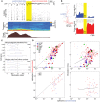Laminar-dependent effects of cortical state on auditory cortical spontaneous activity
- PMID: 23267317
- PMCID: PMC3527822
- DOI: 10.3389/fncir.2012.00109
Laminar-dependent effects of cortical state on auditory cortical spontaneous activity
Abstract
Cortical circuits spontaneously generate coordinated activity even in the absence of external inputs. The character of this activity depends on cortical state. We investigated how state affects the organization of spontaneous activity across layers of rat auditory cortex in vivo, using juxtacellular recording of morphologically identified neurons and large-scale electrophysiological recordings. Superficial pyramidal cells (PCs) and putative fast-spiking interneurons (FSs) were consistently suppressed during cortical desynchronization. PCs in deep layers showed heterogeneous responses to desynchronization, with some cells showing increased rates, typically large tufted PCs of high baseline firing rate, but not FSs. Consistent results were found between desynchronization occurring spontaneously in unanesthetized animals, and desynchronization evoked by electrical stimulation of the pedunculopontine tegmental (PPT) nucleus under urethane anesthesia. We hypothesize that reduction in superficial layer firing may enhance the brain's extraction of behaviorally relevant signals from noisy brain activity.
Keywords: cell-type; cortical circuit; ensemble recording; sensory cortex; slow oscillation.
Figures




References
Grants and funding
LinkOut - more resources
Full Text Sources

